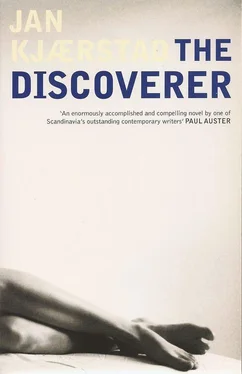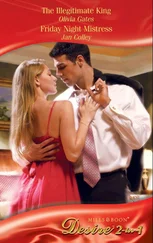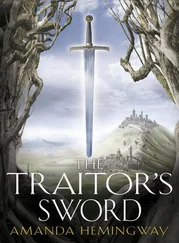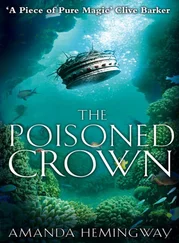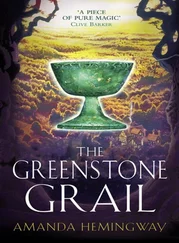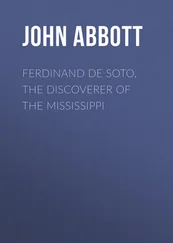Jan Kjaerstad - The Discoverer
Здесь есть возможность читать онлайн «Jan Kjaerstad - The Discoverer» весь текст электронной книги совершенно бесплатно (целиком полную версию без сокращений). В некоторых случаях можно слушать аудио, скачать через торрент в формате fb2 и присутствует краткое содержание. Год выпуска: 2009, Издательство: Arcadia Books, Жанр: Современная проза, на английском языке. Описание произведения, (предисловие) а так же отзывы посетителей доступны на портале библиотеки ЛибКат.
- Название:The Discoverer
- Автор:
- Издательство:Arcadia Books
- Жанр:
- Год:2009
- ISBN:нет данных
- Рейтинг книги:5 / 5. Голосов: 1
-
Избранное:Добавить в избранное
- Отзывы:
-
Ваша оценка:
- 100
- 1
- 2
- 3
- 4
- 5
The Discoverer: краткое содержание, описание и аннотация
Предлагаем к чтению аннотацию, описание, краткое содержание или предисловие (зависит от того, что написал сам автор книги «The Discoverer»). Если вы не нашли необходимую информацию о книге — напишите в комментариях, мы постараемся отыскать её.
The Discoverer — читать онлайн бесплатно полную книгу (весь текст) целиком
Ниже представлен текст книги, разбитый по страницам. Система сохранения места последней прочитанной страницы, позволяет с удобством читать онлайн бесплатно книгу «The Discoverer», без необходимости каждый раз заново искать на чём Вы остановились. Поставьте закладку, и сможете в любой момент перейти на страницу, на которой закончили чтение.
Интервал:
Закладка:
Indirectly, the programme on Harald Hardråde also served as a reminder of Viking times, an age with which all Norwegians were still secretly in love, which is fair enough when one considers that never since has Norway or any other Scandinavian country left such an indelible stamp on the world. By dint of artful little details, rather like a limning of the biographical account, or a juggling act in the background, Jonas Wergeland managed to say something about the double-edged nature of the Viking culture: bloodthirsty, plundering forays which also acted as cross-fertilising cultural exchanges. Viking raids and trading expeditions rolled into one. One caught glimpses, images neatly and almost imperceptibly inserted, of longships — to the Vikings what the horse had been to the Huns — scabbards, drinking horns, runic inscriptions, amulets in the shape of Thor’s hammer and small bronze statuettes of one-eyed Odin. But also there, if one looked carefully, were furs and lumps of amber, gold spurs and silver jewellery, scales and Anglo-Saxon coins, carved wooden caskets and chess pieces made from walrus tusks, parchments covered in writing. Wergeland used a sign from the main street in modernday York — Micklegate — to illustrate how Nordic words had left an enduring mark on the language and names of England, Ireland and Normandy.
But it was the end of the programme that people remembered best, the original depiction of the Battle of Stamford Bridge. After all, who was Harald Hardråde? Harald Hardråde — or Hardrada — was not only an unscrupulous, power-hungry man, a seasoned and victorious warrior who came home from foreign parts with ships so laden with gold that they listed in the water, he was also the only Norwegian ever to have so much as a little finger in the course of history. When he decided, at the age of fifty, to assert his right to the English throne, he timed it so that Harold Godwinson had to divide his attention between two fronts. Harold, then King of England, was in the south, anxiously awaiting William, later to be called the Conqueror. But when Harald Hardråde and his fellow-conspirator, Tostig Godwinson, Harold’s brother, landed in Northumbria the English king was forced to march north to York with all haste. And the bitter and exhausting Battle of Stamford Bridge had only just been won — with Harold losing many of his best warriors, among them some of his indispensable bodyguards — when he received word that William had sailed across the channel and landed in the south. The man who was at that point still King of England had to rush south again, set out on yet another gruelling forced march. Had Harold Godwinson met William and the Normans with a rested and, above all, undepleted army, the Battle of Hastings — although it would have been fought elsewhere and at an earlier date — would in all likelihood have had another outcome. Harold would not have died when that dreadful stray arrow pierced his eye. And the history of Europe would have looked very different.
But it was not so much this, which can never be anything but speculation, albeit interesting speculation — questions are always more important than answers — as the scenes of the battle which stuck in people’s minds. Earlier, Harald Hardråde and Tostig had beaten the armies of the Earls of Northumbria and Mercia at the battle of Fulford Gate, whereupon York surrendered without a fight and accepted Harald as king. On the morning of Monday, 25 September 1066 — one of the most important dates in Norwegian history, right up there with 17 May 1814 and 9 April 1940 — the Norwegians reached Stamford Bridge, about a mile outside of York, either because they were on their way to the town to hold council or to receive hostages from the villages around the bridge, which stood at a spot where many roads met. The question has been raised as to what would have happened had it not rained before the Battle of Waterloo, but one might just as well ask how history would have turned out if the sun had not been shining before the Battle of Stamford Bridge. Because, since the day was uncommonly hot, Harald’s and Tostig’s men had left their vital coats of mail in the boats, in the over two hundred ships anchored at Riccall, where a third of the seven thousand strong army was gathered.
To begin with at Stamford Bridge all Harald and Tostig could see was a cloud of dust. Then they began to make out the glint of weapons — like a wall of ice in the sunlight, a mirage in the heat — as Harold Godwinson’s vast army advanced on the other side of the little River Derwent. Instead of running back to the ships and putting on their chain mail or making a temporary retreat downriver, the Norwegians sent messengers to summon the rest of the army. Then they took up their positions, shield to shield. Rather than run they would all fall together, one on top of the other as Harald had said on a previous occasion, when faced with another apparently superior foe. In the end, after a long, fierce battle, it was Harold Godwinson’s cavalry which tipped the scales. Only thirty or so Norwegian ships sailed back across the North Sea. Harald Hardråde had meant to win the whole of England, but all he got, in the words of the English king, was six feet of its soil — or a foot more because he was so tall.
The truly unforgettable thing about the programme was the way that Jonas Wergeland depicted that mighty battle, over ten thousand men clashing in a hellish, bloody melee, with just one person, Harald Hardråde himself. No one knows for sure where the battlefield lay, nor whether the wooden bridge of that time crossed the river at Danes Well or somewhere else. But Jonas Wergeland used the present stone bridge which, with its patina, could easily pass for a thousand-year-old bridge. He specifically wanted to feature the bridge because of the classic Viking legend which told of how a giant, a red-haired berserker, had single-handedly defended the bridge for several hours before being killed by a sneak attack from below — an event which is actually pictured on the sign outside the Swordsman Inn at Stamford Bridge today. Wergeland decided to have Harald Hardråde take the swordsman’s place. Actor Normann Vaage, tall and well-built and blessed still with the agility of his young days as a promising gymnast, was perfect in the part.
In the programme Harald Hardråde, clad in a blue tunic and silvery helmet, was seen standing on the parapet at the centre of the bridge, battling on alone with a fearsome two-handed sword that sang as it cut through the air. Jonas Wergeland shot this stylised spectacle from the bank of the river in order to get the whole bridge in the shot. One saw Harald, the universal warrior, executing a kind of sword dance. His actions were as acrobatic as they were measured and balletic — again: like the moves in the more meditative forms of the Asian martial arts. And even though there was no sign of the pennants or the barricades of spears or the rain of arrows or the wall of raised shields or the rocks thrown by slings and catapults, viewers were treated — thanks to the soundtrack, a marvellous recreation of the hideous din of battle, with lots of ringing swords and screams and thundering hooves — to the illusion of a real battle. Nothing like it had ever been seen on television before. Jonas Wergeland made viewers see the horde of adversaries, he had them biting their nails, even though Harald Hardråde was quite alone, hacking and slashing at thin air. The Norwegian king fought in lone majesty on a bridge in England, one which also represented a decisive crossroads in European history, but people at home had a clear, vivid impression of a battle surging nerve-rackingly back and forth, and no one could help but see that Harald Hardråde was a splendid warrior, displaying as he did, with his lithe, supple movements, all the resourcefulness and skill in arms he had developed as commander of the Nordic division of the Varangian guard in Constantinople. Harald Hardråde — or Jonas Wergeland, as Kamala Varma once pointed out — seemed to possess one of those astras spoken of in The Mahabharata : a weapon that can create mighty illusions.
Читать дальшеИнтервал:
Закладка:
Похожие книги на «The Discoverer»
Представляем Вашему вниманию похожие книги на «The Discoverer» списком для выбора. Мы отобрали схожую по названию и смыслу литературу в надежде предоставить читателям больше вариантов отыскать новые, интересные, ещё непрочитанные произведения.
Обсуждение, отзывы о книге «The Discoverer» и просто собственные мнения читателей. Оставьте ваши комментарии, напишите, что Вы думаете о произведении, его смысле или главных героях. Укажите что конкретно понравилось, а что нет, и почему Вы так считаете.
